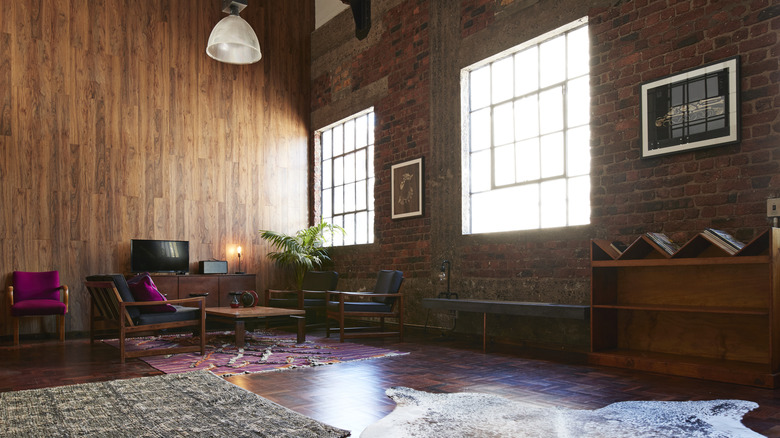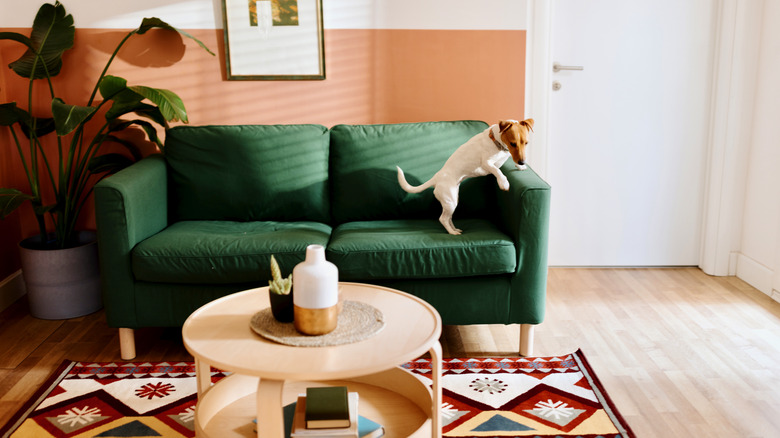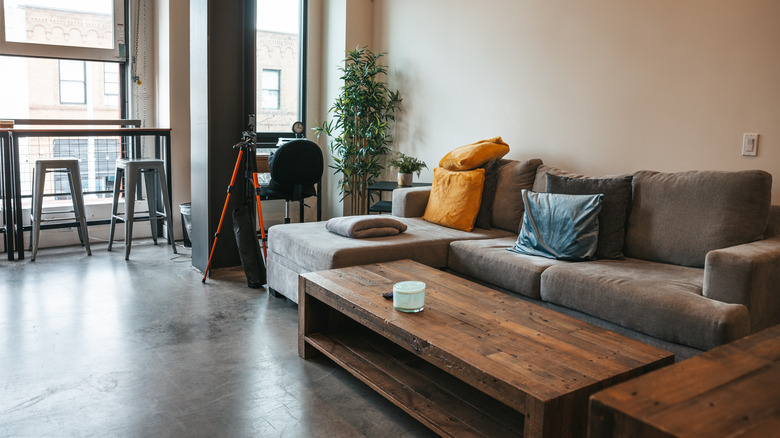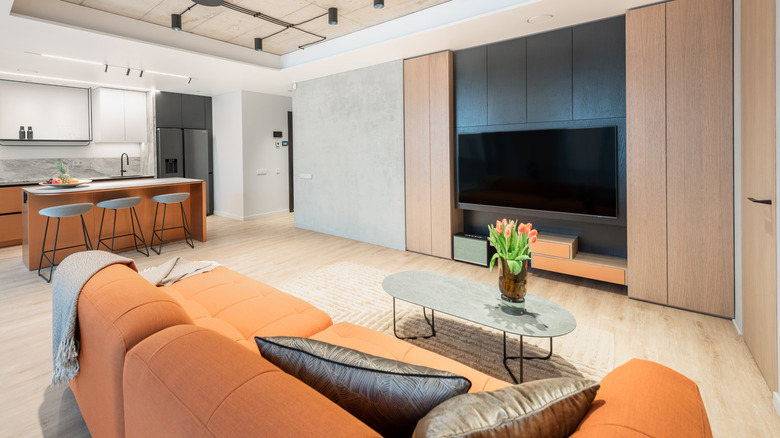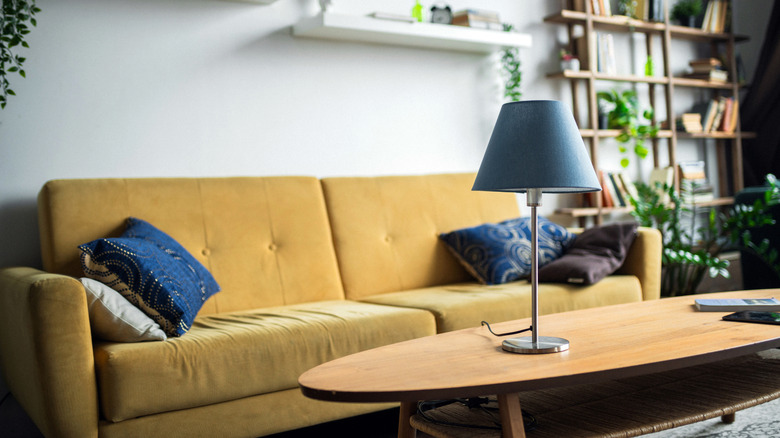The Best Couch Colors For Wood-Rich Interiors
When styled right, a wood-rich interior makes any space feel like a comforting hug, offering a cozy, intimate setting that feels both timeless and luxurious, especially in the living room or den. Of course, too much wood can make the room feel stuffy, stiff, or outdated, so it's important to have balance. One method to achieve this is to choose a couch color that best complements the wood tones. Your sofa is often the focal point or anchoring piece of your living room. It is one of the largest pieces in your space and will guide the rest of your design style, so choosing a hue that pairs beautifully with all your wood will aid in your overall design.
While certain couch colors like cream or white are timeless for nearly any space or design, colors that feel more earthy and organic tend to do better in wood-rich interiors. However, the couch color you choose will greatly depend on the type of wood in your space, as each wood has unique tones and undertones in the grain. Many of today's home designs give the wood drenching trend a modern twist through the intentional placement of contrasting colors and materials. For example, light woods like maple, pine, or bamboo will pair will with grays and yellows, while mid-tone browns like oak or beech could look best with soft blues or deep greens. Dark wood tones like walnut might appear best alongside creams or cool greens. The key is to aim for contrast to complement your existing wood tones and spotlight your sofa.
Earthy greens and olive tones are a match made in heaven
If you want to give your wood-rich interior a modern aesthetic, olive tones and earthy greens are some of the trendiest options. Most wood tones appear in differing shades of brown, though some wood types like purple heart or ebony can seem more red or black, respectively. Though, for many homeowners, pairing shades of green with your brown-based wood tones will offer a cohesive and cozy aesthetic. This is because brown and green are a classic color pairing, often evoking themes of nature or a sense of the outdoors.
Pair dark wood tones with a contrasting sage, olive, mint, or other light green couch. Alternatively, lighter wood tones may look best with darker greens like jewel-toned emerald, deep forest, or charcoal green. It's also best to contrast warm wood undertones with cool ones. If your wood walls or floors have a warmer undertone, consider pairing them with a cooler-toned sofa with blue or gray undertones, such as eucalyptus green. If you prefer the look of a matching undertone in your flooring and sofa, just be sure to choose a distinct enough sofa color so that it stands out rather than fading into the background.
Cool down a dark wood interior with blues, grays, and creams
Dark wood interiors can risk feeling oppressive and daunting, but thankfully, adding cooler, lighter-toned furniture can easily uplift the look of the space. If your floors or walls feature dark woods like walnut or mahogany, incorporate colors with cool blue undertones in your couch. A muted dusty-blue couch can make dark and mid-tone wood interiors pop. If you're working with a space that has deep, red-toned wood like mahogany, opt for a slate gray or slate blue sofa to balance some of the warmer aspects of the woods.
Dark wood is the alluring wood flooring trend that's taking center stage in 2025, so considering complementary couch colors is crucial if you want to explore this trend in your home. For those with ebony or black walnut wood types, soft pale blues like periwinkle may be a better choice. With dark woods, you can also go for a classic couch color like cream or a cool-toned beige to add a lighter touch to the room. However, you may want to avoid stark whites, which could look too out-of-place and sterile in such a deep, cozy environment.
Add a color to pale woods with rust and terracotta hues
Pale woods like pine, bamboo, birch, maple, or white oak often feature yellow undertones. These lighter woods do best with furniture that grounds and warms up the space. However, you'll want to avoid couches that also have yellow undertones, like beige or cream, which could make the space feel flat or monotonous. Instead, choose a sofa with red undertones like a rich, reddish brown or terracotta color. Burnt orange couches also do well atop a light wood floor. If you prefer a neutral sofa, warm, dark browns and leather options could be a good, subtle alternative that balances out light wood tones.
However there are some exceptions to this rule. If your light wood interior already feels too warm due to lighting or has a hint of red undertones, opt for cooler browns like sand or washed-out tan hues. You might also consider choosing a couch in mauve or pink colors with blue or gray undertones to calm down the wood and invite more freshness to the space.
Use mustard to brighten mid to deep wood tones
A mustard yellow couch isn't for the faint of heart. However, in a room with cool wood tones that is in need of more character and warmth, a mustard yellow couch may be the saving grace for your space. Mustard yellow couches suit mid-to-deep wood tones beautifully. You could add it to a walnut wood room for a midcentury feel, or pair your mustard couch with a mid-tone wood like ash.
As a general rule, you should pair warm wood undertones with a cool-toned sofa and cool wood undertones with a warm-toned couch. Because yellow is a very warm sofa color, we recommend avoiding mustard yellow couches in rooms with wood that already features heavy yellow undertones, as this will make the room too monotonous and prevent your couch from being the statement piece. Instead, add this sofa to rooms with soft red undertones or cool undertones in the wood, which will allow it to stand out. Of course, almost any sofa color can work in a wood-rich interior, as long as other factors are kept in-check, such as the decor, curtains, and paint colors for your walls that will complement the wood. Intensity and depth in your color palette are crucial for pulling off the perfect aesthetic that won't clash or fall flat.
